Share
Online survey conducted on November 2022
Cultural diversity awareness is becoming increasingly important especially in a world where we can no longer ignore the diversity of its people. We analyse, perceive and interpret things differently. What is considered as normal in certain cultures may be seen as inappropriate in another culture. This survey attempts to identify the level of university student awareness and sensitivity towards cultural diversity, but it will also allow them to evaluate their own understanding of cultural diversity.
Data analysis
Personal information
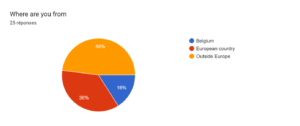
48% of the participants come from outside europe and 36% come from a european country. It indicates the presence of the diversity and mobility factor amongst students who are studying in Belgian universities.
University students’ attitude and knowledge about Cultural Diversity
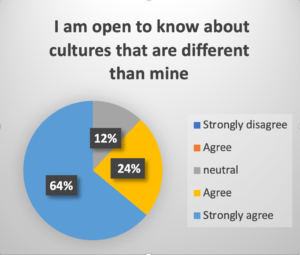
64% of the participants seem to strongly agree with the idea of being open to knowing about different cultures. Being curious and having the will to learn about other cultures reflects the positive view they may have on multiculturalism.
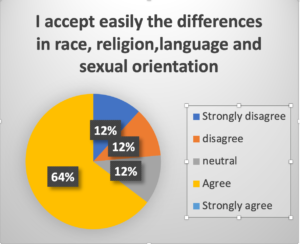
64% of the participants declared having a high level of acceptance of the differences in race, religion, language, and sexual orientation, while 12% don’t accept easily those differences. It can be assumed that culture may influence their level of acceptance of certain differences such as religion or sexual orientation
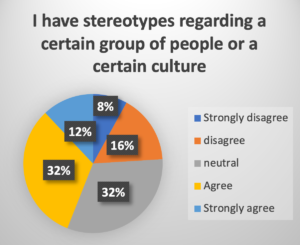
64% of the participants stated that they have stereotypes regarding a certain group of people or a certain culture. It can be explained by the cultural knowledge that individuals build through their experiences in a culture (Bruner, 1990).
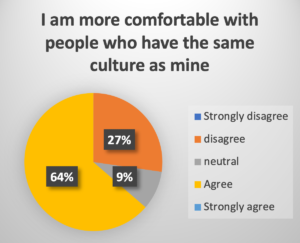
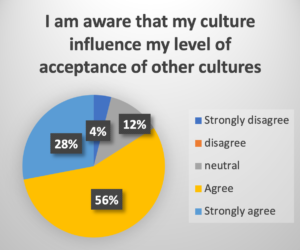
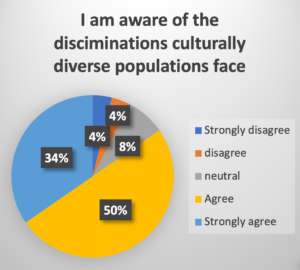

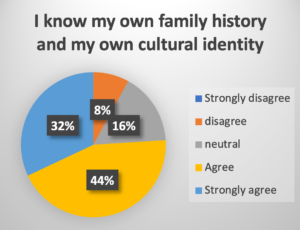
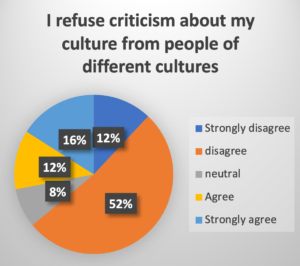
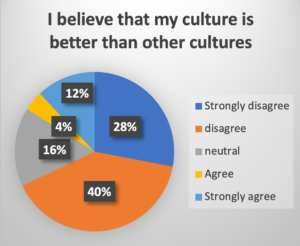

University Students perception on Cultural Diversity
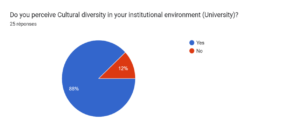

72% of the students feel that their university promotes cultural diversity. This percentage reflects the effort made by teachers and the administration in incorporating diversity in their teaching programs, but also, through the activities (art, sport, cultural exchange…) on campus.
Please justify your answer:
16 answers have been collected and the main forms of promotion students perceived at their universities were: the presence of students with different nationalities, mobility students (Erasmus), teaching in various languages, teaching programs including topics on cultural diversity, having food for specific communities and cultural and educational activities. However, some students reported a negative view based on their own experience, as this one student said: “Topics of cultural diversity are rarely addressed, and when they are, the conversation is not completely free of dear of saying something offensive or shocking or being judged”. Another student stated: “I neither agree nor disagree. Some activities such as speaking tables are organised but, at least at my knowledge, few or non-events such as debates and round tables about cultural diversity.”

80% of students believe that cultural diversity brings people together. This result indicates the positive perception student have of cultural diversity. We can also assume that the sample which is dominated by a student coming from abroad influence their positioning, as they may consider themselves representatives of that cultural diversity.
Please, justify your answer:
17 responses have been collected and after reading the comments I retained two distinct approaches. For the students who believe that cultural diversity brings people together, they see it as an asset in the sense that it brings various perspectives, deconstructs prejudices, all cultures are treated equally, and allows honesty and freedom for people because they can be themselves. One of the participants said: “Cultural Diversity brings most of the time different perspective to any activity that would be done. And in cases of division, I think it would be more of a problem of mindset than a problem of different culture”.
Another student shared his/her positive view about cultural diversity by saying “To my mind, I believe that cultural diversity is bringing individuals from various origins and cultures together and then fostering an atmosphere that not only acknowledges but also embraces the contrasts between those cultures and backgrounds. It facilitates the creation of an environment where individuals may be truly honest.”
However, some students stated that cultural diversity can be seen from both sides and it all depends on how we perceive it and what we do about it. As one of the students said:
“I’m 100% for the fact that we shouldn’t impose our culture on other people. Where I to go live in Japan, I’d be interested in sharing my experience with natives here, but I’d make an effort to adapt to the society because I’m the one going to their place and I was the one choosing to be here for a set of reason…… Doesn’t mean I have to throw away my own culture. I expect the same of others who would come to Belgium. Diversity without limits is chaos and a society with no diversity at all is uncreative and doomed to die.”
Another student who stated the reasons on being sceptical about cultural diversity said: “People are placed into categories and in the subconscious mind of everyone, there is a hierarchical order when it comes to cultural diversity. Some cultures are highly regarded than others….”



Average Rating